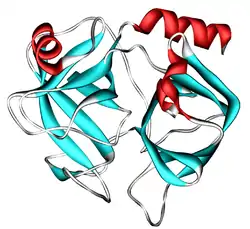Kallikrein
Kallikrein ist ein körpereigenes Hormon, das unter anderem gefäßerweiternd wirkt. Es ist eine Serinprotease, also ein Enzym, das die Aminosäure Serin in seinem aktiven Zentrum enthält und Proteine zu spalten vermag. Kallikrein überführt inaktive Vorläufer von Gewebshormonen in deren aktive Form. Die Vorstufen sind in diesem Fall sogenannte Kininogene, die aktiven Formen werden als Kinine bezeichnet.
| Kallikrein-1 | ||
|---|---|---|

| ||
| Bändermodell nach PDB 1SPJ | ||
| Eigenschaften des menschlichen Proteins | ||
| Masse/Länge Primärstruktur | 238 Aminosäuren | |
| Bezeichner | ||
| Gen-Name | KLK1 | |
| Externe IDs | ||
| Enzymklassifikation | ||
| EC, Kategorie | 3.4.21.35, Serinprotease | |
| MEROPS | S01.160 | |
| Reaktionsart | Hochselektive Hydrolyse | |
| Substrat | Kininogen | |
| Produkte | Kallidin | |
| Vorkommen | ||
| Homologie-Familie | Trypsin | |
| Übergeordnetes Taxon | Lebewesen | |
Kallikrein kommt in den Speicheldrüsen, in der Bauchspeicheldrüse und in den Nieren als glanduläres Kallikrein vor. Im Blutplasma ist die inaktive Vorstufe Präkallikrein vorhanden, die ihrerseits durch den aktivierten Blutgerinnungsfaktor XII (Hageman-Faktor) proteatisch gespalten und in aktives Kallikrein überführt wird. Als endogener Aktivator des Plasminogens ist es an der Fibrinolyse beteiligt. Das System aus Kallikrein und Kininen arbeitet in ähnlicher Weise wie das Renin-Angiotensin-Aldosteron-System und spielt eine Rolle bei der Blutdruckregulation, der Elektrolyt- und Wasserhomöostase und bei entzündlichen Prozessen. Insgesamt sind 15 Subtypen bekannt. Einige Subtypen sind als Tumormarker diagnostisch interessant.
Entdeckt wurde Kallikrein von dem Chirurgen Emil Karl Frey.[1][2][3]
Literatur
- Giorgio Raspi: Kallikrein and kallikrein-like proteinases: purification and determination by chromatographic and electrophoretic methods. In: Journal of Chromatography B. 684, 1996, S. 265–287, doi:10.1016/0378-4347(96)00144-2.
- J. M. Lamdin u. a.: The venomous hair structure, venom and life cycle of Logoa crispata, a puss caterpillar of Oklahoma. In: Toxicon. 38, 2000, S. 1163–1189, PMID 10736472.
- K. D. Bhoola, C. D. Figueroa, K. Worthy: Bioregulation of kinins: kallikreins, kininogens, and kininases. In: Pharmacological Reviews. 44, 1992, S. 1–80, PMID 1313585.
- Stefan Offermanns, Walter Rosenthal: Encyclopedia of Molecular Pharmacology. Springer, 2008, ISBN 978-3-540-38916-3, S. 673.
- B. Giusti, S. Serrati, F. Margheri, L. Papucci, L. Rossi, F. Poggi, A. Magi, A. Del Rosso, M. Cinelli, S. Guiducci, B. Kahaleh, M. Matucci-Cerinic, R. Abbate, G. Fibbi, M. Del Rosso: The antiangiogenic tissue kallikrein pattern of endothelial cells in systemic sclerosis. In: Arthritis Rheum 52 (11), Nov 2005, S. 3618–3628. doi:10.1002/art.21383. PMID 16255054.
- I. P. Michael, G. Pampalakis, S. D. Mikolajczyk, J. Malm, G. Sotiropoulou, E. P. Diamandis: Human tissue kallikrein 5 is a member of a proteolytic cascade pathway involved in seminal clot liquefaction and potentially in prostate cancer progression. In: J Biol Chem 281 (18), May 2006, S. 12743–12750. doi:10.1074/jbc.M600326200. PMID 16517595.
- N. Emami, E. P. Diamandis: Human kallikrein-related peptidase 14 (KLK14) is a new activator component of the KLK proteolytic cascade. Possible function in seminal plasma and skin. In: J Biol Chem. 8;283 (6), Feb 2008, S. 3031–3041. doi:10.1074/jbc.M707253200. PMID 18056261.
- P. Ovaere, S. Lippens, P. Vandenabeele, W. Declercq: The emerging roles of serine protease cascades in the epidermis. In: Trends Biochem Sci. 34 (9), Aug 2009, S. 453–463. doi:10.1016/j.tibs.2009.08.001. PMID 19726197.
- H. Tamura, Y. Ishikawa, N. Hino, M. Maeda, S. Yoshida, S. Kaku, S. Shiosaka: Neuropsin is essential for early processes of memory acquisition and Schaffer collateral long-term potentiation in adult mouse hippocampus in vivo. In: J Physiol. 1;570 (3), Feb 2006, S. 541–551. doi:10.1113/jphysiol.2005.098715. PMC 1479887 (freier Volltext). PMID 16308352.
- C. A. Borgono, E. P. Diamandis: The emerging roles of human tissue kallikreins in cancer. In: Nature Reviews Cancer. 4, 2004, S. 876–890, doi:10.1038/nrc1474.
- E. P. Diamandis, G. M. Yousef: Human Tissue Kallikreins: A Family of New Cancer Biomarkers. In: Clinical Chemistry. 48, 2002, S. 1198–1205, PMID 12142373 (freier Volltext).
Weblinks
- MeSH Kallikrein
- Nomenclature Committee of the International Union of Biochemistry and Molecular Biology (NC-IUBMB): Enzyme Nomenclature. Recommendations.
- ExPASy: Enzyme nomenclature database
Einzelnachweise
- Emil Karl Frey, Heinrich Kraut, Eugen Werle: Kallikrein (Padutin). Stuttgart 1950.
- Hans Rudolf Berndorff: Ein Leben für die Chirurgie. Nachruf auf Ferdinand Sauerbruch. In: Ferdinand Sauerbruch: Das war mein Leben. Kindler & Schiermeyer, Bad Wörishofen 1951; zitiert: Lizenzausgabe Bertelsmann, München 1956, S. 456–478, hier: S. 459.
- Heinrich Kraut, Emil Karl Frey, Eugen Wehrle: Der Nachweis eines Kreislaufhormons in der Pankreasdrüse. In: Zeitschrift für physiologische Chemie. Band 189, 1930, S. 97 ff.